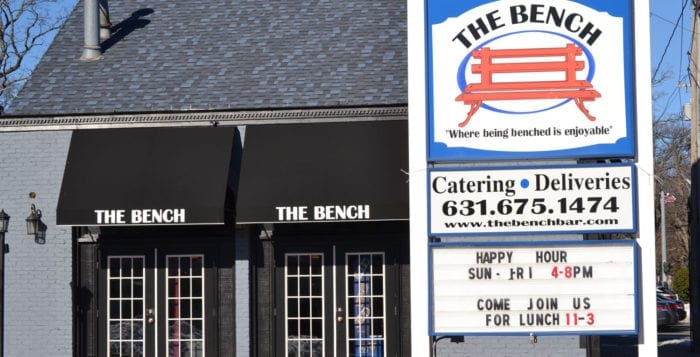By Kevin Redding & Alex Petroski
President Donald Trump’s (R) first month in office and items on his agenda thus far have sparked an activist uprising in blue and red districts alike across the United States. Thursday, two North Shore congressmen made themselves available to concerned constituents, though the formats were different.
First congressional district U.S. Rep. Lee Zeldin (R-Shirley) and 3rd congressional district U.S. Rep. Tom Suozzi (D-Glen Cove) each hosted town hall events Feb. 23 to discuss issues with the people they represent, a trend that has caught on for leaders in nearly all 50 states in the weeks since Inauguration Day. Suozzi hosted nearly 400 residents at Mid Island Y Jewish Community Center in Plainview for about two and a half hours. Zeldin spoke directly to voters in their homes in a telephone town hall.

According to Zeldin, more than 9,000 people sat in on the hour-long call, which featured questions and interactive polls. More than 1,000 others streamed it online. The congressman began the call with an opening statement lasting nearly five minutes, which touched on improving American safety at home and abroad; growing the local economy; supporting veterans and first responders; improving education; repairing infrastructure; repealing and replacing the Affordable Care Act; and safeguarding the environment. He then answered 10 questions from a combination of callers and those streaming the conversation on the internet, submitting written questions.
Groups of constituents have lobbied the congressman to host an in-person town hall in recent weeks, but have been unsuccessful. Changes have also been made to his office hour availability, which he attributed earlier in February to the actions of “liberal obstructionists.” Zeldin justified the decision to hold a telephone town hall rather than a conventional one during the call.
“For years telephone town halls have allowed me to reach the maximum amount of constituents interested in constructive dialogue,” he said. “This is a modern way to bring a town hall directly to your home.”
He evaluated the effectiveness of the format in an email through spokeswoman Jennifer DiSiena the following day.
“These outreach efforts with the public have proven to be extremely effective and allow him to productively reach the maximum amount of constituents who are interested in constructive dialogue,” she said. “It is true that liberal obstructionists cannot disrupt the call.”
A Facebook group called “Let’s Visit Lee Zeldin,” set up by constituents attempting to speak to the congressman face-to-face, which has more than 2,000 members, followed along with the call and held a discussion regarding Zeldin’s responses on the page. Several posters said they registered to be called on Zeldin’s website, but never received it, or received it after its commencement at 7 p.m.

A post asking if any questions were not addressed during the call received more than 100 responses. One constituent asked if the congressman would put pressure on the House Oversight Committee to investigate Trump’s ties to Russia. Another asked about the shrinking middle class and growing income inequality. Someone else asked, “What will Zeldin do to assure females have safe affordable birth control/reproductive rights?”
Zeldin was asked on the call, among several other questions, about his stance on the Trump administration’s reversal of transgender bathroom guidelines set by the Obama administration — he said he supported the reversal. Another question involved Trump’s slow response to anti-Semitic violence and demonstrations across the U.S. since election day — which Zeldin condemned, though added he appreciated Trump speaking up this week. Several questions came in concerning the ACA and what will take its place once repealed — the congressman said he supported the proposed Health Care and Education Reconciliation Act, coverage for those with preexisting conditions, allowing kids to stay on parents’ plans until age 26, and would support a voucher program for veterans.
DiSiena addressed Zeldin’s plans going forward regarding a traditional town hall.
“Way too many of the people at the moment requesting town halls across the country are doing so with the purpose of disrupting the town hall without any interest at all in decorum,” she said.
Former U.S. Rep. Gabby Giffords (D-Arizona), who was shot during an outdoor, public meeting with constituents in 2011, called on members of Congress to “face their constituents” and hold town halls in a tweet Feb. 23.
DiSiena said Zeldin is open to small meetings, though no in-person town hall is currently planned. DiSiena disclosed results of one of the five poll questions Zeldin posed to listeners during the call, showing most constituents, 23 percent, are concerned about health care above all other issues.
Conversely, Suozzi stood and engaged a large crowd of residents and activists, answering more than 30 questions on a variety of hot topics, including the repeal of the ACA, the relationship between Trump and Russian President Vladimir Putin, and Trump’s travel restriction executive order. He also voiced his disapproval of what’s happening in the White House, and called on those in attendance to “not hate Trump supporters” and instead turn their anger into something productive.

“I think this is as American as you can get … this is so inspiring and this country needs this type of engagement,” Suozzi told the crowd, saying in all his years of holding town hall meetings — both as a congressional candidate and mayor of Glen Cove — he’s never seen an attendance like what he had.
“We need to take all this energy and excitement that we’ve got and use it in a constructive fashion … to work together to win the battles,” he said. “Write letters to the editor, attend issues meetings, run for office, support people for local office. What we really need are reasonable Americans that will put their country before their party to help us to get Congressional support on [issues]. Don’t underestimate what’s working.”
A civil discourse on ideas and plenty of smiles and laughs, Suozzi’s session had a different tone than the heated ones across the country, in which angry constituents waged vocal war against Republican representatives.
Suozzi began the gathering by telling attendees — some of whom represented local activist groups like North Shore Indivisible, MoveOn.org, and Science Advocacy of Long Island — to be respectful and direct all comments to him.
Attendees raised questions about Trump’s ties to Russia, the release of the commander-in-chief’s taxes, gun violence, immigration, climate change and the state of health care.
One attendee, Jessica Meyer, who has cerebral palsy, asked the congressman if he would help those like her who fear people with disabilities might lose benefits with the potential repeal of the ACA.
“People with disabilities are getting lost in this conversation,” she said.
Suozzi responded to her concerns.
“I want you to know that I will fight tooth and nail to protect you, personally, and everybody in your situation, and I want to hear from everybody in this room who’s going to fight to protect Jessica,” Suozzi said.
Harry Arlin, a World War II and Korean War veteran from Huntington, said he lived briefly under Adolf Hitler in Germany and Joseph Stalin in Russia, though fled both countries.
“I’m too old to run again,” he said.
Seven-year-old Zachary Aquino echoed Arlin’s sentiments.
“I don’t think this is right having Trump as president, I think it’s really bad,” he said. “I don’t know how this happened — how we got stuck in this mess — but it’s good that we’re here today … this is a really valuable time. Fighting against Trump is very good. We’ve got to do this.”

When asked what he was going to do to restore one attendee’s faith in “American exceptionalism,” Suozzi pointed around the room.
“This is it — this is people who believe and should not walk out of here with anything but a stronger belief that by being involved, you can actually have an impact on things,” he said.
The White House has made claims recently to suggest some activists attending town halls are being paid to be there and rile up crowds, a sentiment which Zeldin echoed in a Feb. 18 Facebook post.
“Liberal obstructionists are disrupting, resisting and destructing public events all around America,” he wrote. “Our neighbors want to actually engage in substantive, productive, constructive dialogue, and the liberal obstructionists are spitting on them with their shameful shows for their own political theater.”











 “I think he was someone that really believed in a cause. In his case, the cause was an independent America and he was willing to sacrifice his time and his family’s time to make that happen. He certainly took great personal risks as a general and, again, as president, he sacrificed his time and the rest of his life was dedicated towards the country.
“I think he was someone that really believed in a cause. In his case, the cause was an independent America and he was willing to sacrifice his time and his family’s time to make that happen. He certainly took great personal risks as a general and, again, as president, he sacrificed his time and the rest of his life was dedicated towards the country. “I’ve been in the Legislature for six years, and got elected in 2011, which was then-president Obama’s third year in office. I had been a physician and I was a big participant in getting involved in the hope and change … Obama being the first Black American president was inspirational for me as one of the few Black American elected officials.
“I’ve been in the Legislature for six years, and got elected in 2011, which was then-president Obama’s third year in office. I had been a physician and I was a big participant in getting involved in the hope and change … Obama being the first Black American president was inspirational for me as one of the few Black American elected officials. “If you were in my office, whether in Albany or here in the district, you would see lots of pictures of Abraham Lincoln. When you’re growing up and you’re reading about different presidents, the idea of Lincoln being kind of a frontiersman and the way he grew up and the stories about him are very exciting. As you get older and you start looking into Lincoln’s life, you see the kind of person that he is. He cared very deeply about people and if you look at photos of Lincoln, you could see the deep lines, as some people call “worry lines,” because he cared so much. During the Civil War, he visited wounded soldiers and was very touched by their lives.
“If you were in my office, whether in Albany or here in the district, you would see lots of pictures of Abraham Lincoln. When you’re growing up and you’re reading about different presidents, the idea of Lincoln being kind of a frontiersman and the way he grew up and the stories about him are very exciting. As you get older and you start looking into Lincoln’s life, you see the kind of person that he is. He cared very deeply about people and if you look at photos of Lincoln, you could see the deep lines, as some people call “worry lines,” because he cared so much. During the Civil War, he visited wounded soldiers and was very touched by their lives.










